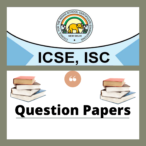HISTORY & CIVICS
H.C.G. – Paper – 1
PART I
![]() Q.1 (a) Name the bill that cannot originate in the Rajya Sabha.
Q.1 (a) Name the bill that cannot originate in the Rajya Sabha.
(b) What is meant by the term ‘quorum’?
(c) What is the maximum gap allowed between the two parliamentary sessions?
(d) Who administers the oath of office to the Council of Ministers?
(e) What is an Ordinance?
(f) State any one reason why the President is elected indirectly.
(g) State any one administrative function of the Cabinet.
(h) Name any two writs issued by the Supreme Court.
(i) Name the highest criminal court in a district.
(j) What is meant by Lok Adalats?
![]() Q.2 (a) Mention any two economic factors responsible for the growth of nationalism in India.
Q.2 (a) Mention any two economic factors responsible for the growth of nationalism in India.
(b) Name the two Presidents under whom the first two sessions of the Indian National Congress were held.
(c) Name the nationalist who said, ‘Swaraj is my birthright and I shall have it’. State any one of his contributions to the National Movement.
(d) State any two objectives of the Muslim League.
(e) State any two causes that led to the Civil Disobedience Movement in 1930. (f) Name the last Viceroy of India. State any one of the provisions of the Indian Independence Act of 1947.
(g) Give any two similarities between the ideologies of Nazism and Fascism.
(h) Name the countries that formed the Axis Bloc, during World War II.
(i) Give the full form of UNESCO.
(j) State any two principles of ‘Panchsheel’ in the Non-Aligned Movement.
PART II
SECTION A
![]() Q.3 With reference to the Union Parliament, answer the following questions:
Q.3 With reference to the Union Parliament, answer the following questions:
(a) How many members may be nominated to the Lok Sabha and the Rajya Sabha? Give one reason as to why they may be nominated to the Lok Sabha.
(b) Mention any three qualifications required for a member to be elected to the Lok Sabha.
(c) What is meant by the term ‘Session’? Name the three Sessions of the Union Parliament.
![]() Q.4 The President and the Vice-President are part of the Union Executive. In this context, answer the following questions:
Q.4 The President and the Vice-President are part of the Union Executive. In this context, answer the following questions:
(a) State any three qualifications required for a candidate to be elected as the Vice President of India.
(b) State the three functions of the Vice-President.
(c) Explain briefly any two Legislative and any two Executive powers of the President.
![]() Q.5 Our Judicial system has a Supreme Court at its Apex, followed by the High Court and other subordinate Courts. In the light of this statement, explain the following:
Q.5 Our Judicial system has a Supreme Court at its Apex, followed by the High Court and other subordinate Courts. In the light of this statement, explain the following:
(a) Any three types of cases in which the Supreme Court exercises its Original Jurisdiction.
(b) Any three ways by which the Constitution ensures the Independence of the Judiciary.
(c) ‘Advisory’ and ‘Revisory’ Jurisdiction of the Supreme Court.
SECTION B
![]() Q.6 Numerous causes gave rise to the First War of Independence and its consequences led to several changes in the British Government in India. In this context, answer the following:
Q.6 Numerous causes gave rise to the First War of Independence and its consequences led to several changes in the British Government in India. In this context, answer the following:
(a) Explain any three political causes of the Revolt of 1857.
(b) Briefly explain the immediate cause of the Great Revolt.
(c) State any four changes in the administration of the British Government as a consequence of the Revolt.
![]() Q.7 The Quit India Resolution in 1942 was one of the final calls given by Gandhi for the British to leave India. Moving towards Independence, Lord Mountbatten’s Plan was significant. In this context, answer the following:
Q.7 The Quit India Resolution in 1942 was one of the final calls given by Gandhi for the British to leave India. Moving towards Independence, Lord Mountbatten’s Plan was significant. In this context, answer the following:
(a) State two reasons for the launching of the Quit India Movement.
(b) Give any three effects of the Quit India Movement launched by Gandhi in 1942 that was significant to the last phase of the National Movement of India.
(c) Give any four clauses of the Mountbatten Plan of 1947.
![]() Q.8 Study the picture given below and answer the following questions:
Q.8 Study the picture given below and answer the following questions:
(a) Identify the leader given in the picture. Name the Political party and the Military Organisation that he formed.
(b) State any three objectives of the Political party that he founded.
(c) Mention any four objectives of the Military Organisation that he formed.
![]() Q.9 With reference to the Two Major World Wars in the 20th century, answer the following questions:
Q.9 With reference to the Two Major World Wars in the 20th century, answer the following questions:
(a) Explain briefly the causes of World War I with reference to Nationalism and Imperialism.
(b) Explain briefly the territorial rearrangements as a result of World War I.
(c) State any four causes that led to the Second World War.
![]() Q.10 With reference to the United Nations and its Specialized Agencies, answer the following:
Q.10 With reference to the United Nations and its Specialized Agencies, answer the following:
(a) Mention any three functions of the International Court of Justice.
(b) State the composition of the General Assembly.
(c) State any two functions of the UNICEF and any two functions of WHO.
(c) State any two functions of the UNICEF and any two functions of WHO.


